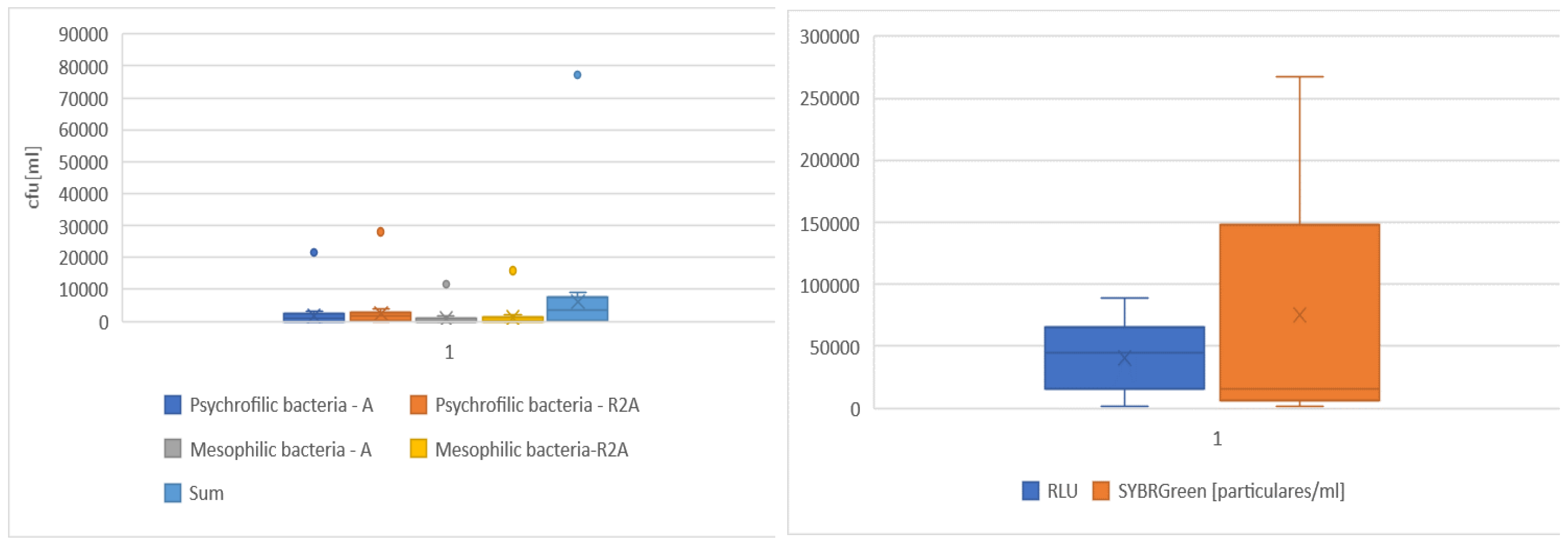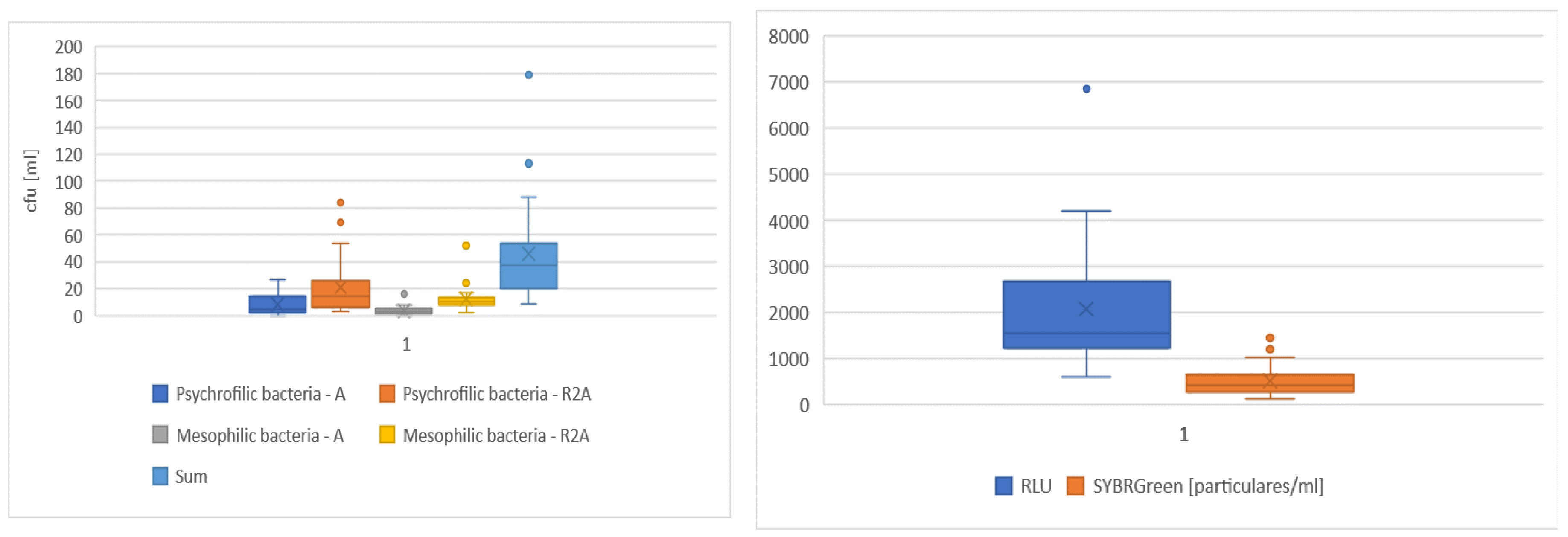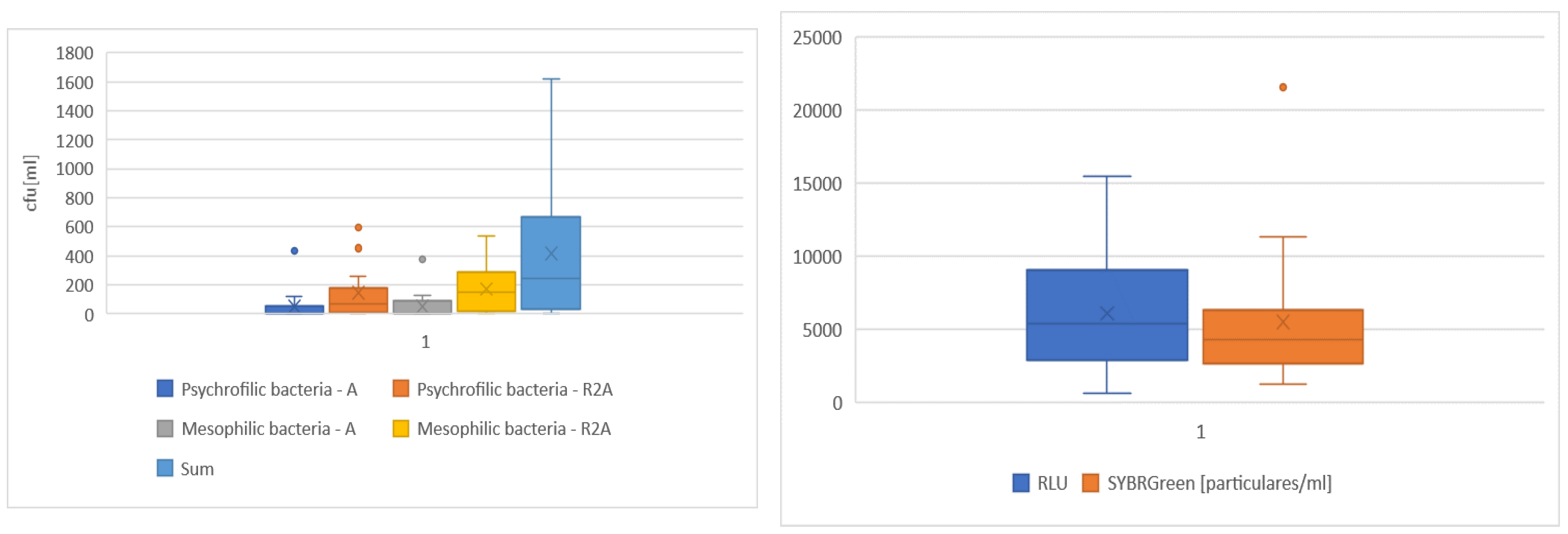Submitted:
25 October 2023
Posted:
25 October 2023
You are already at the latest version
Abstract
Keywords:
1. Introduction
2. Materials and Methods
2.1. Research material
2.2. Methodology of bacteriological determinations
2.3. Statistical analysis
3. Results and discussion
3.1. Surface water
- −
- the number of mesophilic bacteria on both tested agars,
- −
- RLU values, and the number of psychrophilic bacteria on Agar A and R2A,
- −
- total number of bacteria determined and the RLU value.
3.2. Rainwater
- −
- sum of all bacteria, and psychrophilic bacteria on R2A agar,
- −
- sum of all bacteria, and mesophilic bacteria on R2A agar,
- −
- number of psychrophilic bacteria on agar A and agar R2A,
- −
- the number of psychrophilic bacteria on Agar A, with the number of mesophilic bacteria on agar R2A,
- −
- number of mesophilic bacteria on agar A and R2A.
3.3. Grundwater
- −
- number of psychrophilic and mesophilic bacteria on both agars,
- −
- the number of mesophilic bacteria and the sum of all bacteria,
- −
- RLU value and the number of mesophilic bacteria on agar A,
- −
- RLU value and the number of mesophilic bacteria on R2A agar,
- −
- RLU value and the sum of all bacteria.
3.4. Tap water
- −
- the number of psychrophilic bacteria on R2A agar and the sum of all bacteria,
- −
- the number of mesophilic bacteria on R2A agar and the sum of all bacteria.
4. Conclusions
- The number of bacteria assessed on Agar R2A for all types of analyzed waters were higher compared to the reference Agar A. The lowest values of standard deviation for 4 groups of bacteria (psychrophilic and mesophilic bacteria on both agars) in waters with low bacteriological contamination were obtained for groundwater.
- The total number of bacteria quite strongly correlates with the RLU values for surface and groundwater. This suggest the possibility of using the luminometric ATP determination for the quick assessment of the microbiological quality of this type of water.
- Quite strong correlations between the RLU values and cytometrically determined particle number were observed for rainwater
- Strong and relatively strong linear relationships for the tested microbiological parameters differ in each of the assessed waters.
- −
- In the case of surface water, the microbiological quality was highly dependent on the season during which the research was conducted. Low Pearson’s correlation coefficients factors indicate the lack of linear relationships for cytometric determinations with other microbiological water parameters examined. In case of cytometric determinations, the obtained result should be correlated with autofluorescence.
- −
- The microbiological quality of rainwater is highly variable. Very strong correlations were found for the determination of the bacteria number performed with the use of culture methods. On the other hand, low values of linear correlation were obtained for the number of bacteria, and the values obtained by cytometry and luminometry methods.
- −
- In the case of non-disinfected groundwater of very good microbiological quality, it is suggested to quickly measure and evaluate the microbiological quality using the luminometric method of ATP determination.
- −
- For tap water, no linear correlation was found between the number of bacteria obtained with the culture methods and the values of RLU and the number particles measured with the flow cytometer. Such a result indicates the presence of uniform microflora of the examined waters. On the other hand, the luminometric measurements may have been influenced by extracellular ATP, which was released from microbial cells during ozonation. This indicates the need to assess the concentration of extracellular ATP for disinfected tap water.
Author Contributions
Funding
Acknowledgments
Conflicts of Interest
References
- Maier R.M.; Pepper I.L; Gerba Ch.P. Environmental Microbiology, Secend Edidtion , Academic Press, 2009.
- Błaszczyk M. Environmental microbiology, PWN, Warszawa 2010.
- Kalsoom M.; Rehman F.; Shafique T.; Junaid S.; Khalid N.; Adnan M.; Zafar I.; Tariq M.A.; Raza M.A.; Zahra A.; Ali H. Biological importance of microbes in agriculture, food and pharmaceutical industry: a review, Innovare Journal of Life Sciences, 2020,Vol 8, Issue 6, 1-4. [CrossRef]
- Berry D., Xi CH., Raskin L. Microbial ecology of drinking water distribution systems, Curr. Opin. Biotechnnol, 2006, 17930, 297-302. [CrossRef]
- Mara D.; Horan N. Handbook of Water and Wastewater Microbiology, Academic Press, 2003.
- Caggiano G.; Diella G.; Triggiano F.; Bartolomeo N.; Apollonio F.; Carmen Campanale C.; Lopuzzo M.; Maria Montagna M.T. Occurrence of Fungi in the Potable Water of Hospitals, A Public Health Threat: Pathogens, 2020, 9, 783. [CrossRef]
- Gonçalves A.B.; Paterson, R.R.M.; Lima, N. Survey and significance of filamentous fungi from tap water. International Journal of Hygiene and Environmental Health, 2006, 209, 257-264. [CrossRef]
- Hageskal G.; Lima, N.; Skaar I. The study of fungi in drinking water. Mycological Research, 2009, 113: 165-172. [CrossRef]
- Frimmel F.H.; Saravia F.; Gorenflo F. NOM removal from different raw waters by membrane filtration, Water Sci.Technol. 2004, 4, 16-174. [CrossRef]
- Jones M.R.; Pinto E.; Torres, M A.; Dörr F.; Mazur-Marzec H.; Szubert K.; Tartaglione L.; Dell'Aversano C.; Miles, Ch. O.; Beach D. G.; McCarron P.; Sivonen K.; Fewer D.P.; Jokela J.; Janssen E. M.-L. CyanoMetDB, a comprehensive public database of secondary metabolites from cyanobacteria, Water Research, 2021, Vol. 196, 15. [CrossRef]
- Helmreich B.; Horn H. Opportunities in rainwater harvesting. Science Direct, Desalination, 2009, 248, 118- 124. [CrossRef]
- Georgios D.; Gikas Vassilios A.; Tsihrintzis A. Assessment of water quality of first-flush roof runoff and harvested rainwater, Journal of Hydrology, 2012, 466-467, 115-126. [CrossRef]
- Proctor C.R.; Hammes F. Drinking water microbiology – from measurement to management. ScienceDirect, Current Opinion in Biotechnology, 2015, 33, 87-94. [CrossRef]
- Jo W.K.; Kang J.H. Workplace exposure to bioaerosols in pet shop, pet clinics and flower garden, Chemosphere, 2006, 65, 1755-1761. [CrossRef]
- Amin M.T.; Han M.Y. Improvement of solar based rainwater disinfection by using leman and vinegar as catalysts. Desalination, 2011, 276, 416-424. [CrossRef]
- Cullimore D.R. Practical manual of groundwater microbiology, CRC Press, 2007, ISBN-13: 978-0849385315.
- Bienz K.; Eckert J.; Kayser F.; Zinkernagel R. Medical microbiology, Wydawnictwo Lekarskie PZWL, Warszawa 2007.
- Liu S., Grunawan C.; Barraud N.; Rice S.A.; Harry E.J.; Amal R. Understanding, Monitoring and Controling Biofilm Growth in Drinking Water Distribution Systems, Environ. Sci. Technol., 2016, 50, 17, 8954–8976 . [CrossRef]
- Świderska - Bróż M.The effects of the presence of biofilm in water distribution systems intended for human consumption, Ochrona Środowiska, 2012, 1, 9-14.
- Pierścieniak M.; Trzcińska N.; Słomczyński T.; Wąsowski J. The problem of secondary contamination of tap water, Ochrona Środowiska i Zasobów Naturalnych, 2009, 39, 29-32.
- Łebkowska M.; Pajor E.; Rutkowska-Narożniak A.; Kwietniewski M.; Wąsowski J.; Kowalski D. Research on the development of microorganisms in water supply pipes made of ductile iron with cement lining, Ochrona Środowiska, 2011, Vol. 33, 3, 9-16.
- Liu G., Zhang Y.; Knibbe W.; Feng C.; Liu W.; Medema G.; Meer W. Potential impacts of changing supply-water quality on drinking water distribution: A review, Water Research, 2017, 116, 136-137. [CrossRef]
- Grabińska – Łoniewska A.; Siński E. Pathogenic and potentially pathogenic microorganisms in aquatic ecosystems and water supply networks, Wydawnictwo „Seidel-Przywecki” Sp. z o.o., Warszawa, 2010.
- Cabral J. Water Microbiology. Bacterial Pathogens and Water, International Journal of Environmental Research and Public Health, 2010, 7, 3657-3703. [CrossRef]
- Hammes F.; Berney M.; Wang Y.; Vital M.; Köster O.; Egli T.. Flow-cytometric total bacterial cell counts as a descriptive microbiological parameter for drinking water treatment processes, Water Res., 2008, 42 (1-2), 269-77. [CrossRef]
- Hammes F.; Egli T. New Method for Assimilable Organic Carbon Determination Using Flow-Cytometric Enumeration and a Natural Microbial Consortium as Inoculum, Environ. Sci. Technol., 2005, 39 (9), 3289-3294. [CrossRef]
- Velten S.; Hammes F.; Boller M.; Egli T. Rapid and direct estimation of active biomass on granular activated carbon through adenosine tri-phosphate (ATP) determination, Water Res., 2007, 41(9),1973-83. [CrossRef]
- Magic-Knezev A.; Van Der Kooij D.. Optimisation and significance of ATP analysis for measuring active biomass in granular activated carbon filters used in water treatment, Water Res., 2004, 38(18), 3971-9. [CrossRef]
- Elhadidy A.M.; Van Dyke M.I.; Peldszus S.; Huck P.M. Application of flow cytometry to monitor assimilable organic carbon (AOC) and microbial community changes in water, Journal of Microbiological Methods, 2016, 130, 154-163. [CrossRef]
- Joachimsthal E.L.; Ivanov V.; Tay J-H.; Stephen T. Flow cytometry and conventional enumeration of microorganisms in ships’ ballast water and marine samples, Marine Pollution Bulletin, 2003, 46 (3), 308-313. [CrossRef]
- Pinfold J.; Nigel V.; Horan J. Measuring the effect of a hygiene behaviour intervention by indicators of behaviour and diarrhoeal disease, Transactions of The Royal Society of Tropical Medicine and Hygiene, 1993, Vol. 90, Issue 4, 366-371. [CrossRef]
- Uba B.N.; Aghogho O. Rainwater quality from different roof catchments in the Port Harcourt district, Rivers State, Nigeria, Journal of Water Supply, Research and Technology-Aqua, 2000, 49 (5), 281-288. [CrossRef]
- Handia L.; Madalitso J.; Tembo J.; Mwiindwa C. Potential of rainwater harvesting in urban Zambia, Physics and Chemistry of the Earth, Parts A/B/C, 2003, 28 (20-27), 893-896. [CrossRef]
- Despins CH.; Farahbakhsh K.; Leidl CH. Assessment of rainwater quality from rainwater harvesting systems in Ontario, Canada, Journal of Water Supply: Research and Technology AQUA, 2009, 117-135. [CrossRef]
- Lee J.Y.; Yang J-S.; Han M.; Choi J. Comparison of the microbiological and chemical characterization of harvested rainwater and reservoir water as alternative water resources, Science of the Total Environment, 2010, 408, 896-905. [CrossRef]
- Polkowska Ż.; Astel A.; Walna B.; Małek S.; Mędrzycka K.; Górecki T.; Siepak J.; Namieśnik J. Chemometric analysis of rainwater and throughfall at several sites in Poland, Atmospheric Environment, 2005, 39 (5), 837-855. [CrossRef]
- Fewtrell L.; Kay D. Microbial quality of rainwater supplies in developed countries: a review, Urban Water Journal, 2007, 4, 253-260. [CrossRef]
- Melidis P.; Akratos Ch.S.; Tsihrintzis V.A.; Trikilidou E.. Characterization of Rain and Roof Drainage Water Quality in Xanthi, Greece, Environmental Monitoring and Assessment, 2007, 127 (1-3), 15-27. [CrossRef]
- Sazakli E.; Alexopoulos A.; Leotsinidis M. Rainwater harvesting, quality assessment and utilization in Kefalonia Island, Greece, Water Research, 2007, 41 (9), 2039-2047. [CrossRef]
- Tsakovski S.; Tobiszewski M.; Simeonov V.; Polkowska Ż.; Namieśnik J. Chemical composition of water from roofs in Gdansk, Poland, Environmental Pollution, 2010, 158 (1), 84-91. [CrossRef]
- Evans C.A.; Coombes P.J.; Dunstan R.H. Wind, rain and bacteria: The effect of weather on the microbial composition of roof-harvested rainwater, Water Research, 2006, 40 (1), 37-44. [CrossRef]
- Deininger R.A.; Lee J.Y.. Rapid determination of bacteria in drinking water using an ATP assay, 2001. [CrossRef]
- Siebel E.; Wang Y.; Egli T.; Hammes F. Correlations between total cell concentration, total adenosine tri-phosphate concentration and heterotrophic plate counts during microbial monitoring of drinking water, Drink. Water Eng. Sci., 2008, 1, 1-6. [CrossRef]
- Vital M.; Hammes F.; Egli T. Competition of Escherichia coli O157 with a drinking water bacterial community at low nutrient concentrations, Water Research, 2012, 46 (19), 6279-6290. [CrossRef]
- Lautenschlager K.; Hwang CH.; Liu W.T.; Boon N.; Köster O.; Vrouwenvelder H.; Egli T.; Hammes F. A microbiology-based multi-parametric approach towards assessing biological stability in drinking water distribution networks, Water Research, 2013, 47 (9), 3015-3025. [CrossRef]
- Liu G.; Van Der Mark E.J; Verberk J.J.C.; Van Dijk J.C. Flow Cytometry Total Cell Counts: A Field Study Assessing Microbiological Water Quality and Growth in Unchlorinated Drinking Water Distribution Systems, BioMed Research International, 2013, . [CrossRef]
- Delahaye E.; Welté B.; Levi Y.; Leblon G.; Montiel A. An ATP-based method for monitoring the microbiological drinking water quality in a distribution network, Water Research, 2003, 37 (15), 3689-3696. [CrossRef]
- Maki J.S.; Lacroix S.J.; Hopkins B.S.; Staley J.T. Recovery and diversity of heterotrophic bacteria from chlorinated drinking waters, Applied and Environmental Microbiology, 1986, 51 (5), 1047-1055 . [CrossRef]
- Eydal H.S.C.; Pedersen K. Use of an ATP assay to determine viable microbial biomass in Fennoscandian Shield groundwater from depths of 3–1000 m, Journal of Microbiological Methods, 2007, 69A (4), 273-280. [CrossRef]
- Hammes F.; Egli T. Cytometric methods for measuring bacteria in water: ad-vanteges pitfalls and application, Anal. Bioanal. Chem., 2010, 397 (3), 1083—1095. [CrossRef]
- Stevens M.; Köhler D.; Göhde R. Flow Cytometric enumeration of total bacterial cell count (TCC) in drinking water with the Partec Cyflow® Cube 6 flow cytometer, Görlitz 72, 2013, 12.
- Vang Ó.K.; Corfitzen C.B.; Smith C; Albrechtsen H.J. Evaluation of ATP measurements to detect microbial ingress by wastewater and surface water in drinking water. Water Res., 2014, 64, 309-320. [CrossRef]




| Tested parameter | Method / Standard |
|---|---|
| Total bacteria count at 22 ° (72h) | Culture method on standard nutrient agar; PN-EN ISO 6222:2004 |
| Total bacteria count at 37 °C (48h) | |
| Enumeration of microorganisms | Partec Cube 6 flow cytometer |
| ATP concentration | Luminometric determination; www.promega.com/protocols |
| Average | Psychrophilic bacteria AGAR A | Psychrophilic bacteria AGAR R2A | Mesophilic bacteria AgarA | Mesophilic bacteria AgarR2A | Sum | RLU | The number of particles SYBRGreen | |
|---|---|---|---|---|---|---|---|---|
| Psychrophilic bacteria AGAR A | 43724 | 1,000 | 0,985 | 0,753 | 0,710 | 0,988 | 0,780 | 0,111 |
| Psychrophilic bacteria AGAR R2A | 62397 | - | 1,000 | 0,764 | 0,732 | 0,993 | 0,832 | 0,116 |
| Mesophilic bacteria AgarR2A | 85326 | - | - | 1,000 | 0,951 | 0,820 | 0,647 | 0,126 |
| Mesophilic bacteria AgarR2A | 13590 | - | - | - | 1,000 | 0,789 | 0,611 | 0,217 |
| Sum | 128235 | - | - | - | - | 1,000 | 0,813 | 0,128 |
| RLU | 459769 | - | - | - | - | - | 1,000 | 0,093 |
| The number of particles SYBRGreen | 236571 | - | - | - | - | - | - | 1,000 |
| Average | Psychrophilic bacteria AGAR A | Psychrophilic bacteria AGAR R2A | Mesophilic bacteria AgarA | Mesophilic bacteria AgarR2A | Sum | RLU | The number of particles SYBR Green | |
|---|---|---|---|---|---|---|---|---|
| Psychrophilic bacteria AGAR A | 1834 | 1,000 | 0,994 | 0,981 | 0,982 | 0,997 | 0,532 | 0,389 |
| Psychrophilic bacteria AGAR R2A | 2307 | - | 1,000 | 0,984 | 0,974 | 0,996 | 0,519 | 0,411 |
| Mesophilic bacteria AgarR2A | 823 | - | - | 1,000 | 0,982 | 0,991 | 0,491 | 0,419 |
| Mesophilic bacteria AgarR2A | 1361 | - | - | - | 1,000 | 0,988 | 0,458 | 0,375 |
| Sum | 632 | - | - | - | - | 1,000 | 0,509 | 0,401 |
| RLU | 41687 | - | - | - | - | - | 1,000 | 0,725 |
| The number of particles SYBR Green | 93781 | - | - | - | - | - | - | 1,000 |
| Average | Psychrophilic bacteria AGAR A | Psychrophilic bacteria AGAR R2A | Mesophilic bacteria AgarA | Mesophilic bacteria AgarR2A | Sum | RLU | The number of particles SYBR Green | |
|---|---|---|---|---|---|---|---|---|
| Psychrophilic bacteria AGAR A | 8 | 1,000 | 0,852 | 0,461 | 0,476 | 0,851 | 0,609 | 0,497 |
| Psychrophilic bacteria AGAR R2A | 21 | - | 1,000 | 0,621 | 0,670 | 0,968 | 0,697 | 0,264 |
| Mesophilic bacteria AgarR2A | 3 | - | - | 1,000 | 0,766 | 0,738 | 0,842 | 0,270 |
| Mesophilic bacteria AgarR2A | 12 | - | - | - | 1,000 | 0,809 | 0,768 | 0,316 |
| Sum | 44 | - | - | - | - | 1,000 | 0,798 | 0,361 |
| RLU | 267 | - | - | - | - | - | 1,000 | 0,287 |
| The number of particlesSYBR Green | 2069 | - | - | - | - | - | - | 1,000 |
| Average | Psychrophilic bacteria AGAR A | Psychrophilic bacteria AGAR R2A | Mesophilic bacteria AgarA | Mesophilic bacteria AgarR2A | Sum | RLU | The number of particles SYBR Green | |
|---|---|---|---|---|---|---|---|---|
| Psychrophilic bacteria AGAR A | 52 | 1,000 | 0,531 | 0,308 | 0,500 | 0,650 | 0,016 | 0,013 |
| Psychrophilic bacteria AGAR R2A | 144 | - | 1,000 | 0,784 | 0,857 | 0,953 | 0,153 | -0,014 |
| Mesophilic bacteria AgarR2A | 54 | - | - | 1,000 | 0,721 | 0,802 | 0,110 | -0,025 |
| Mesophilic bacteria AgarR2A | 166 | - | - | - | 1,000 | 0,932 | 0,266 | -0,044 |
| Sum | 416 | - | - | - | - | 1,000 | 0,184 | 0,003 |
| RLU | 9291 | - | - | - | - | - | 1,000 | 0,053 |
| The number of particles SYBR Green | 5308 | - | - | - | - | - | - | 1,000 |
Disclaimer/Publisher’s Note: The statements, opinions and data contained in all publications are solely those of the individual author(s) and contributor(s) and not of MDPI and/or the editor(s). MDPI and/or the editor(s) disclaim responsibility for any injury to people or property resulting from any ideas, methods, instructions or products referred to in the content. |
© 2023 by the authors. Licensee MDPI, Basel, Switzerland. This article is an open access article distributed under the terms and conditions of the Creative Commons Attribution (CC BY) license (http://creativecommons.org/licenses/by/4.0/).





